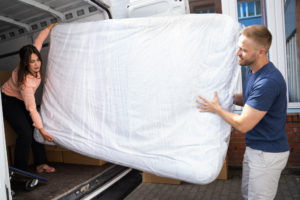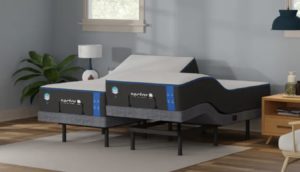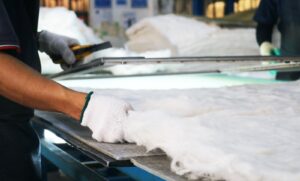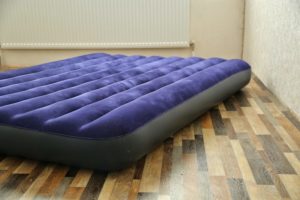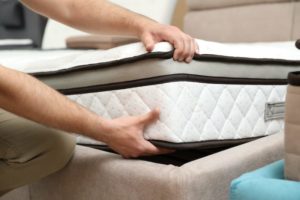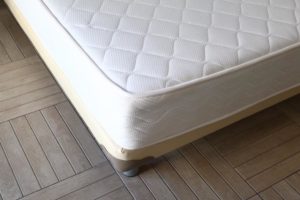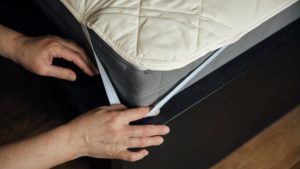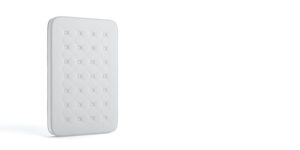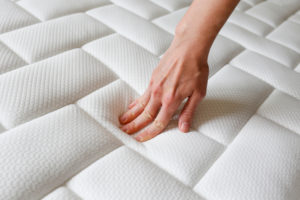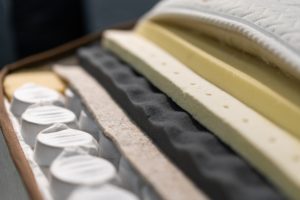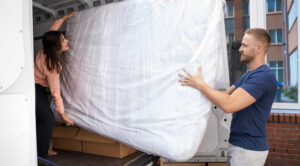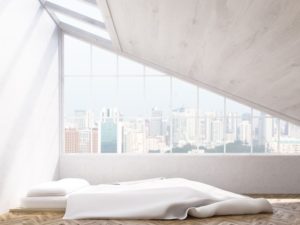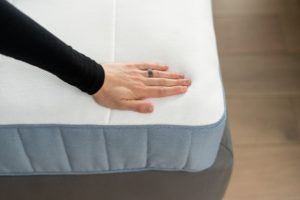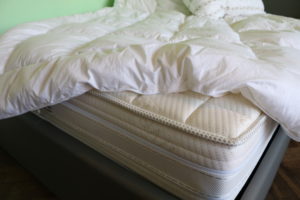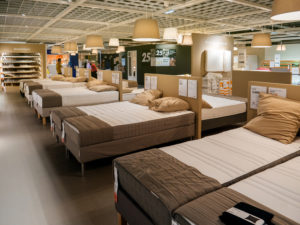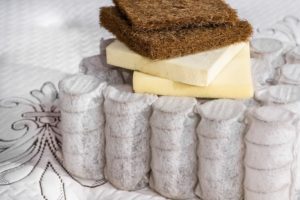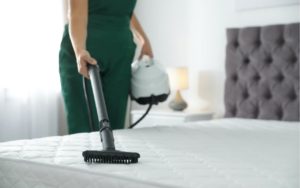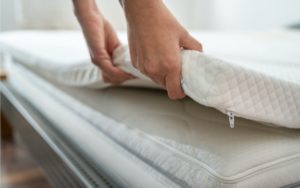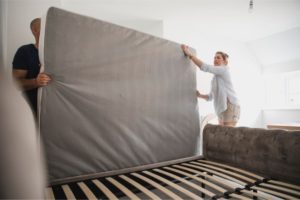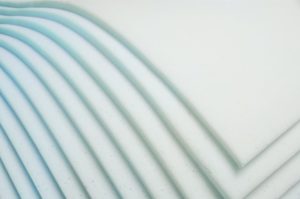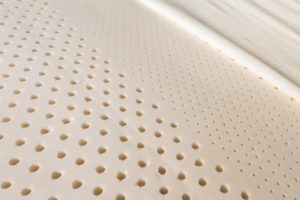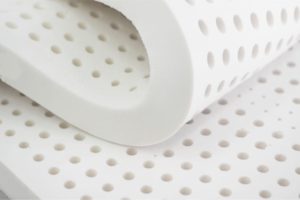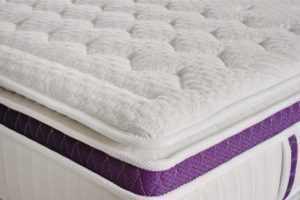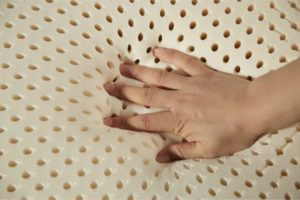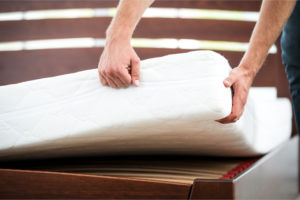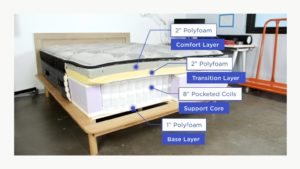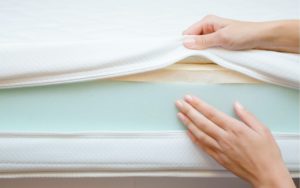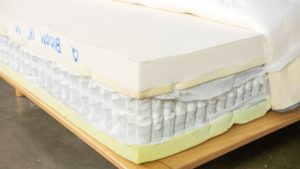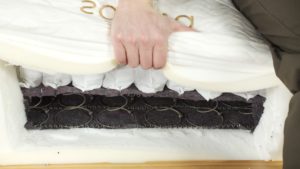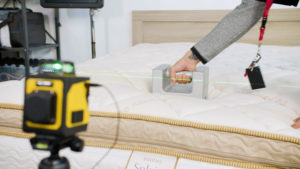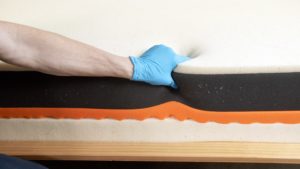Mattress Glossary
Mattress shopping can be overwhelming, and the plethora of special vocabulary doesn’t make it any easier. For many shoppers, unique and unfamiliar mattress vocabulary only adds to the confusion. That’s why we’ve developed a comprehensive mattress glossary to help translate the industry’s common terminology related to mattress construction, performance, sizing, and policies.
Mattress Construction Terms
If you’re like most people, you’ve probably never thought much about how mattresses are made. But without the right background knowledge, you’ll have a hard time distinguishing between features and understanding what makes each model distinct.
Therefore, it’s especially important to understand mattress construction terms. We’ll give you a basic understanding of how the layers of a mattress combine to make a sleep surface.
Base Layer: The thick lower layer of a mattress. Also known as the support core, the base layer is usually made of metal springs, dense polyfoam, Dunlop latex, or adjustable air chambers. This mattress component provides support and durability while preventing excessive sinkage.
Comfort Layer: The uppermost layer of the mattress. The composition of the comfort layer has the largest impact on the overall feel since you sleep on it directly. Most models use softer materials for cushioning and contouring. If a mattress has more than one comfort layer, manufacturers may refer to the layers as a comfort system. Common materials include memory foam, polyfoam, latex, wool, and fiber.
Cover: The outer fabric layer of a mattress. Most covers are integrated and non-removable. In many cases, extra padding sewn in adds cushioning.
Density: A measure of mass per volume. For mattresses, the density of foam or latex may be measured in pounds per cubic foot (PCF). Denser materials are typically firmer and more durable.
Durability: How well a mattress withstands wear and tear. Most mattresses have an average lifespan between 7 and 10 years. Factors that affect durability include mattress type, material quality, construction quality, body weight, and mattress care.
Let us help you find the perfect bed
Answer a few questions to find the right mattress for your unique needs
Euro-Style Pillow-Top (Euro-Top): A top layer that adds plushness to your bed’s comfort system. With a design distinct from a traditional pillow-top, Euro-style pillow-tops are flush with the surface of the mattress and tend to be denser than a regular pillow-top layer.
Fire Sock: A stretchy, fire-resistant material often made from wood pulp, sand, or fiberglass that surrounds the inside of the mattress to protect it from combustion. Some mattress components are not inherently fire-resistant and require a protective barrier to meet federal safety guidelines.
Fire Barrier: A generic term for any chemical treatment or fabric casing intended to prevent the interior comfort and base layers of your mattress from catching fire. Federal safety guidelines require that all mattresses sold in the U.S. pass an open-flame test. To meet these guidelines and protect sleepers from potential fire hazards, mattress manufacturers must include fire barriers composed of either chemical flame retardants or naturally fire-resistant materials in every mattress model.
Insulator Layer: A layer in innerspring mattresses that acts as a barrier between the comfort system and the support core. The insulator layer prevents the sleep surface from sinking into the spring system and may also modify the feel.
Mattress Core: Another term used to describe the base or support layer of a mattress. The mattress core creates a sturdy, durable base and provides support to the comfort layers. It may contain coils, polyfoam, latex, or air chambers.
Natural Fibers: Fiber from natural sources, such as plants and animals. Natural fibers may be used in the mattress cover or as part of a layer. Cotton and wool are among the most common natural fibers used in mattresses.
Pillow-Top: A gusseted top comfort layer that adds extra plushness to your sleep surface. Usually made of fiber or foam, a pillow-top is sewn into the top of the mattress and sits above the rest of the comfort system.
Polybrominated diphenyl ethers (PBDEs): A commonly used flame retardant applied to many consumer products, including mattresses.
Quilting Layer: A cushioning layer of foam or fibers stitched into the cover. This layer typically enhances pressure relief, but it can also affect breathability and temperature regulation.
Support Layer: Used interchangeably with “base layer” and “mattress core.” Support layers are typically thicker and denser than the comfort system. Common materials include innerspring coils and high-density polyfoam, though latex and air chambers also appear in some models.
Ticking: The cover of the mattress. Ticking is often made from tightly woven cotton, viscose, or synthetic blend fabric. It affects the mattress’ breathability, durability, and feel.
Transition Layer: A layer found between the comfort system and support core that acts as a bridge between the two parts of the mattress. Not all models have transitional layers. However, they can help enhance the performance of the comfort system and prevent sleepers from sinking into the support core.
Zoned Support: A design feature in which the firmness of the sleep surface varies to provide targeted support and cushioning. This usually promotes good posture and relieves pressure points.
Mattress Feel & Performance Terms
When buying a mattress online, you usually can’t try it before you buy it. Although online mattress retailers traditionally offer at-home sleep trials with generous return policies, choosing a model that meets your needs on the first try can save you time and effort. We’ll define the most important terms to help you evaluate a mattress’ feel and performance.
Body Impressions: Lasting indentations from lying on the mattress. Minor impressions are common as mattresses with foam comfort layers age, but deeper sagging could make the bed uncomfortable. Most warranties cover indentations over a certain depth.
Bounce: A rebounding effect. A mattress with ample bounce quickly regains its original shape when weight is removed. Bouncy mattresses allow for better ease of movement but also tend to cause greater motion transfer.
Breathability: How well air flows through a material. Breathable mattress components generally keep the sleep surface cooler.
Comfort: A subjective quality associated with physical relief and relaxation. Mattress comfort is determined by a sleeper’s personal preferences. While firmness level plays a major role, conforming, support, motion isolation, and other factors also contribute.
Conforming: How much a mattress molds to the shape of your body. Conforming influences pressure relief and comfort.
Contouring: Synonymous with conforming, contouring describes how much a sleep surface hugs your body to redistribute weight and relieve pressure.
Deep Compression Support: The ability to support body parts that tend to sink more deeply into the sleep surface, such as the hips. Deep compression support is important for promoting proper spinal alignment, especially for sleepers who weigh over 230 pounds.
Ease of Movement: How freely you can move on a mattress. Ease of movement affects many nightly activities, including getting in and out of bed, changing sleep positions, and having sex. Bouncier mattresses tend to have better ease of movement.
Edge Support: How well a bed supports your body weight at its outermost perimeter. Strong edge support increases the usable surface area of a mattress.
Firmness: How hard or soft a mattress feels. Mattress firmness is closely related to comfort. Mattress brands may use different terms to describe the firmness of their mattresses. We use a 1 through 10 scale to help you make direct comparisons between models and manufacturers.
Motion Isolation: The ability to prevent vibrations on one side of the sleep surface from transferring to other areas. When a mattress has poor motion isolation, it’s easy to feel when your sleep partner changes positions and gets into or out of bed.
Off-Gassing: The process of releasing chemical odors associated with newly manufactured mattresses. Experts do not typically consider off-gassing smells harmful, but they can be unpleasant. Certain materials, such as polyfoam and memory foam, tend to undergo more noticeable off-gassing.
Point Elasticity: The degree to which a material compresses at one location without affecting other areas. A material with high point elasticity, like memory foam, allows for greater contouring by compressing directly under pressure. Materials with low point elasticity, such as latex, spread the force over a wider area for more of a floating sensation.
Pressure Relief: How a mattress minimizes tension and force against the body. A mattress with ample pressure relief cushions key points, like the hips and shoulders, to redistribute their weight and promote proper spinal alignment. The degree of pressure relief you need depends on your sleep position and body weight.
Responsiveness: Synonymous with bounce. Highly responsive materials, such as coils, return to their original shape quickly when weight is removed, making them bouncier and easier to move on.
Sex: How well a mattress performs during intimate activities. Several factors contribute to a bed’s suitability for sex. A slight bounce makes movement easier, edge support increases the usable surface area, and moderate contouring provides pressure relief and traction without too much sinkage.
Sinkage: Another way to describe contouring or conforming. Sinkage refers to how deeply a mattress envelops the curves of your body.
Support: How well a mattress holds up the body to promote a neutral spinal position. The core of the mattress should act as the main pillar of support by preventing the pelvis from sinking too deeply into the mattress relative to lighter body parts. The contouring of the comfort system is intended to complement the support core by filling in gaps in the body’s profile to keep the spine in its natural alignment.
Support Factor: A measure of progressive resistance for foam and latex that tabulates the ratio between the material’s 25% compression factor and its 65% compression factor. In other words, the support factor compares how much force it takes to compress the materials to different degrees. Most foam has a support factor between 1 and 3, and latex usually varies between 3 and 5. However, mattress manufacturers rarely report this value. A higher support factor is usually indicative of more support and higher quality.
Spinal Alignment: The positioning of the spine relative to its natural curvature and how it lines up with the rest of the body. Improper spinal alignment can cause pain in the back and other parts of the body.
Temperature Control: How well a mattress helps regulate temperatures to prevent overheating. Breathability and heat retention are important contributing factors.
Mattress Purchase Terms
The process of buying a mattress online involves a whole new set of terms beyond mattress construction and performance. To understand the true value of any mattress model, you’ll need to decipher the industry-specific policies and options.
We provide you with general descriptions of mattress purchase terms. Keep in mind that while many companies use the same terms, the specifics of policies vary from brand to brand.
Break-in Period: The mandatory period you need to try your new mattress before requesting a return during a sleep trial. Mattress manufacturers that offer in-home sleep trials frequently require a break-in period between 2 weeks and 30 days to ensure sleepers have a chance to adjust.
Comfort Guarantee: Typically used to refer to a company’s exchange policy. Many mattress retailers have a timeframe during which customers can exchange their mattress for a different model of equal or lesser value if they’re not satisfied.
Old Mattress Removal: An option to have your old mattress removed and disposed of when your new mattress arrives. This service may be available with White Glove delivery.
Mattress-in-a-Box: Any mattress model that is compressed, vacuum-sealed, rolled, and boxed for delivery. This is most common among online retailers and allows for easy and inexpensive shipping.
Mattress Warranty: A guarantee from the manufacturer that protects against material and manufacturing defects. Most mattress warranties last between 5 to 25 years and apply to the original purchaser. Damage resulting from abuse, misuse, and normal wear and tear is not covered. The owner may be responsible for shipping and handling fees associated with repairs and replacements. Terms and conditions apply, so read the fine print.
Trial Period: Also known as an at-home trial or sleep trial, this perk allows you to try out a mattress in the comfort of your own home. A trial period covers a set amount of time and may include a mandatory break-in period. If you’re not satisfied with your new mattress, you can request a return or exchange within this window. Most online mattress companies offer trial periods of around 100 days.
White Glove Delivery: A premium delivery option in which a team delivers your new mattress, sets it up, and disposes of the packaging. Old mattress removal may be included, though some companies charge extra.
Mattress Certification Terms
Many shoppers are concerned about chemicals in their mattresses. Some manufacturers make bold claims about the safety of their products, but customers often look to third-party testers for an unbiased analysis. We’ll break down the most common independent mattress certifications.
CertiPUR-US: A certification program for foam materials sold in the United States. The CertiPUR-US label indicates that the foam in your mattress was made without phthalates restricted by the Consumer Product Safety Commission, ozone depleters, formaldehyde, PBDE, TDCPP, TCEP, mercury, lead, and other heavy metals. CertiPUR-US certified foam must also meet standards for low volatile organic compound (VOC) emissions.
Certified Organic: A certification for organic materials, such as cotton, latex, and wool. Organic certifications are typically associated with limited chemical usage and environmentally sustainable practices, but standards differ depending on the certifying agency. The Global Organic Textile Standard (GOTS) and the Global Organic Latex Standard (GOLS) are two of the most rigorous organic standards in the mattress industry.
eco-INSTITUT: A certification that indicates a product has been independently tested for VOC emissions.
Global Organic Textile Standard (GOTS): A rigorous certification for organic textiles, such as cotton and wool. This standard includes independent, third-party verification of a manufacturer’s entire textile supply chain. In addition to organic fiber requirements, GOTS also includes environmental and social criteria for chemical inputs and working conditions.
Global Organic Latex Standard (GOLS): Similar to GOTS, GOLS is an organic certification label for natural latex. GOLS-certified latex must meet standards pertaining to its contents as well as social and environmental practices.
GREENGUARD: Products with GREENGUARD certification have undergone a manufacturing process review and routine testing to verify low emissions. GREENGUARD Gold certification has more stringent standards, including health-based and emission criteria.
OEKO-TEX Standard 100: Administered by OEKO-TEX, the Standard 100 tests textiles for harmful substances.
Rainforest Alliance: A program that certifies socially, economically, and environmentally sustainable practices. This certification is most common for natural latex.
Sustainable Furnishings Council: An organization established by manufacturers and retailers to promote sustainable practices in the home furnishings industry. Members agree to a pledge, but compliance is not independently verified.
Foam Mattress Terms
The mattress industry has embraced foam for its versatility and ability to cushion key pressure points. An innerspring or hybrid mattress may use foam in its comfort layer, while all-foam models use the material in both the comfort system and support core.
Because of the unique properties of foam, the best foam mattresses usually excel in motion isolation and pressure relief.
Adaptive Polyfoam: A special formulation of polyurethane foam that molds to the body without the close hug of memory foam. This material is also more responsive for greater ease of movement.
Convoluted Foam: A type of foam with a dimpled texture similar to an egg carton. This unique shape provides added breathability and deep compression support. Convoluted foam consists of polyfoam or memory foam and can appear in a mattress’ comfort, transition, or support layer. It is also a common material for mattress toppers.
Copper-Infused Foam: Polyfoam or memory foam formulated with copper. Copper infusions are generally intended to conduct heat away from the body and inhibit microbial growth.
Foam Density: A measurement of weight compared to volume. Typically measured in pounds per cubic foot (PCF), foam density correlates with durability and often firmness.
Gel Memory Foam: Memory foam with small beads or swirls of gel interspersed throughout. The gel may vary in composition depending on the manufacturer, but the main objective is almost always to improve the temperature control.
Indentation Deflection Force (IDF): Another term for indentation load deflection (ILD).
Indentation Load Deflection (ILD): How much force is required to compress foam or latex by 25%. A higher ILD rating typically corresponds to a firmer material. In the past, mattress manufacturers referred to ILD as indentation deflection force (IDF).
Memory Foam: A type of close-conforming, high-density polyfoam originally developed by NASA. Also known as viscoelastic foam, memory foam has high point elasticity and compresses proportionally to weight. It also softens in response to body heat, lending to a distinct hugging sensation. Because of its contouring, memory foam is most common in comfort and transition layers.
Polyurethane Foam (Polyfoam): A type of foam that can vary significantly in feel and performance depending on the specific formulation. Because polyfoam is so versatile, this material is common in both comfort and support layers.
Support Foam: High-density foam used in the core of a mattress. Most support foam is firm, dense polyfoam.
Hybrid and Innerspring Mattress Terms
Hybrid mattresses and innerspring models use metal coils in their support cores. We’ll share definitions for the different coil types you may encounter.
Bonnell Coils: Hourglass-shaped coils interconnected with helical wires. Bonnel coils tend to be inexpensive and less responsive.
Coil Count: How many coils a mattress or individual mattress layer contains. Coil count typically increases with mattress size. However, this measurement alone does not offer meaningful information about a bed’s feel, performance, or durability. It should be considered in combination with a bed’s coil gauge, coil type, and overall construction.
Coil Gauge: Coil thickness. Mattress coil gauges typically range from 13 to 17. Higher gauges equate to thinner coils and a softer feel.
Coil-on-Coil: Two layers of metal coils in one mattress. The top layer generally consists of pocketed coils or microcoils in the comfort system, while the lower layer may use virtually any type of coils to provide support.
Continuous Coils: A continuous network of coils made from the same piece of wire. Continuous coils tend to be firm, stable, durable, and inexpensive.
Hybrid Mattress: A mattress made with a coil support core and a significant foam or latex comfort system. A hybrid mattress aims to combine the best qualities of innerspring and all-foam mattresses while minimizing their downsides.
Innerspring Mattress: A style of mattress with a coil core, a fabric cover, and little to no cushioning material. Most mattress companies have phased out production of this older mattress style due to lack of demand. However, some budget-friendly models are still available.
Microcoils: A thin layer of coils, usually between 1 and 3 inches thick, included as a comfort or transition layer. Microcoils can help improve the bed’s responsiveness, support, temperature control, and durability.
Minicoils: Another name for microcoils.
Nanocoils: A smaller version of microcoils, often under an inch thick.
Offset Coils: Hourglass-shaped coils with squared-off sides and a hinging effect for enhanced contouring. Offset coils are similar to Bonnell but tend to be more responsive, quieter, and better at contouring. They’re also typically more expensive.
Pocketed Coils: Coils that are individually wrapped in fabric sleeves, also known as Marshall coils or wrapped coils. Each coil can move independently, allowing for better contouring and minimal motion transfer. Pocketed coils are common in hybrid mattresses.
Wrapped Coils: Another term for pocketed coils.
Latex Mattress Terms
Latex mattresses use the material in their comfort and support layers. Prized for their durability and balance between resilience and contouring, latex mattresses are steadily growing in popularity. Additionally, many latex models use natural materials, decreasing the off-gassing potential while appealing to eco-conscious shoppers. Some hybrid and all-foam models also use latex in their comfort systems.
Blended Latex: A formulation that combines synthetic and natural latex. Some blended latex may also contain less expensive fillers, such as clay or sand.
Dunlop Latex: A dense, durable variety of latex produced using the Dunlop process. The process involves frothing the sap and steam-baking it in a mold. Dunlop latex may be used in a comfort system or support core.
Natural Latex: Latex made primarily from rubber tree sap. Natural latex typically contains at least 95% sap, but it may include other agents needed for the curing process.
Organic Latex: Certified organic latex meets certain sourcing and processing standards. GOLS is the most common organic certification for latex.
Synthetic Latex: Latex made from petrochemicals, also known as styrene-butadiene rubber (SBR). Synthetic latex tends to be more affordable but less durable than natural alternatives.
Talalay Latex: A softer, airier form of latex produced through the Talalay process. This process involves frothing rubber tree sap, pouring it into a mold, vacuum-sealing the mold, freezing it, and baking it. Because of its lighter feel and gentle contouring, Talalay latex most often appears in the comfort system.
Mattress Accessory Terms
Mattress accessories help you get the most out of your mattress. Having quality sheets and the best pillows is often essential to comfort. However, larger accessories, such as a bed frame, adjustable base, mattress protector, or mattress topper, can also improve both the comfort and longevity of your bed.
Adjustable Base: A support system that allows you to modify the position. Most models let you elevate your head and feet independently via remote control or app. This can improve comfort and may help alleviate a range of nighttime ailments, including snoring, back pain, acid reflux, swelling, and congestion.
Base: A general term for the structure that supports your mattress and adds height. The most common types of bases include boxsprings, foundations, platform beds, slatted bases, and adjustable bases.
Bed Frame: A structure that elevates the sleep surface. It may support the mattress, the foundation, or both depending on its design. Usually made of wood or metal, a bed frame typically has at least four legs and an outer perimeter. Some bed frames also include a platform, a headboard, or a footboard.
Boxspring: A base that includes a wooden frame and sturdy coils. Boxsprings were originally designed to support innerspring mattresses.
Foundation: Generally, a base constructed with a wooden frame and slats. However, the term is sometimes used interchangeably with “base.”
Mattress Cover: A general term to describe a material that wraps around the mattress to shield the surface. When describing an accessory, the expression generally refers to a mattress protector. However, the same term can also be applied to the non-removable fabric ticking that encases a mattress.
Mattress Encasement: A mattress protector that fully surrounds the mattress on all six sides for more comprehensive coverage from contaminants.
Mattress Protector: A protective cover that acts as a barrier against dust mites, mold, and other allergens, as well as stains. Most mattress protectors are waterproof, machine-washable, and go on the bed like a fitted sheet.
Mattress Topper: An extra cushioning layer that rests on top of the mattress. Mattress toppers are typically 1.5 to 4 inches thick and can modify the firmness, pressure relief, contouring, and height of your mattress as well as protect its surface from wear and tear.
Platform Bed: A bed frame with a built-in solid or slatted base. Platform beds are usually low-profile, modern in aesthetic, and relatively affordable due to their simple, all-in-one design.
Miscellaneous Mattress Terms
A lot goes into making a mattress. As a result, some terms don’t fall into a clear category. To make sure nothing slips through the cracks, we’ve included a grab bag of additional mattress vocabulary relating to oversized mattresses, mattress pricing, mattress care, and more.
Alaskan King: A square mattress that measures 108 inches by 108 inches. The Alaskan king is one of the most well-known and widely available oversized mattress sizes, though it remains relatively uncommon. It’s also the longest oversized option.
Alberta King: An oversized square mattress that measures 96 inches by 96 inches. The Alberta king is a foot shorter on each side than the Alaskan king.
California King: The longest of the standard mattress sizes, measuring 72 inches wide by 84 inches long. Although the California king is 4 inches longer than a regular king, it’s also 4 inches narrower.
California Queen: A non-standard mattress size that typically measures 60 inches wide by 84 inches long. The California queen is 4 inches longer than a standard queen.
Family: An extra-wide rectangular mattress that usually measures either 144 inches by 80 inches or 120 inches by 80 inches. As the name suggests, this mattress is designed to accommodate multiple sleepers and pets.
Family XL: A longer version of the family size mattress. The family XL is the largest mattress size, typically measuring 144 inches by 84 inches.
Flipping: Some mattresses have a sleep surface on either side. Known as flippable or reversible beds, these models can be flipped to switch between the two surfaces. Flipping a mattress allows you to increase its usable lifespan by spreading out the wear and tear. Some flippable mattresses also have different firmness levels on each side. However, shoppers should note that most models have just one usable side and therefore should not be flipped.
Hypoallergenic: A material that’s less likely to cause an allergic reaction. It can refer to bedding, specific materials, or the mattress as a whole. Hypoallergenic mattresses typically resist dust mites, mold, mildew, and other allergens.
Texas King: An oversized rectangular bed that measures 80 inches by 98 inches. The Texas king is 8 inches wider than a California king and over a foot longer.
Twin XL: A longer version of the standard twin bed size, measuring 38 inches wide by 80 inches long. Like a twin, the twin XL can only accommodate one sleeper but provides extra legroom.
Value: A balance between the sticker price, discounts, customer service policies, and overall comfort and quality of a mattress.
Volatile Organic Compounds (VOCs): A byproduct of some manufacturing processes that can lead to off-gassing odors and reduced indoor air quality.
Wyoming King: The smallest square oversized mattress, measuring 84 inches by 84 inches. The Wyoming king is the same length as a California king but a foot wider. It may fit into a bedroom more easily than other oversized options.

Still have questions? Ask our community!
Join our Sleep Care Community — a trusted hub of sleep health professionals, product specialists, and people just like you. Whether you need expert sleep advice for your insomnia or you’re searching for the perfect mattress, we’ve got you covered. Get personalized guidance from the experts who know sleep best.

